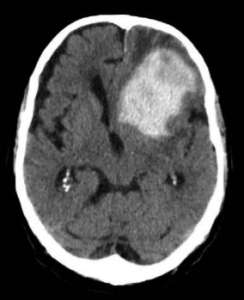

MedFriendly®


High Density
The term "density" is sometimes used to refer to the degree
that a body structure or substance appears dark on an x-ray
picture. Different body structures and substances absorb x-
rays (a form of energy) at different rates. Blood and bone
absorb x-rays at a high rate and appear white on x-ray
pictures. When looked at on an x-ray picture, blood and
bone are referred to as areas of high density. Air and water
absorb x-rays at low rates and appear black on x-ray
pictures. When looked at on an x-ray picture, air and water
are referred to as areas of low density. Brain tissue is
between high density and low density, and is gray in
appearance on x-ray pictures. It should be noted that
whereas a relatively new bleed in the brain appears white,
blood that has been around in the brain for a long time will
appear dark because it does not absorb x-rays as well.
Thus, a new bleed will show up as a high density area,
whereas an old bleed will show up as a low density area.
A large brain bleed shown
on a brain CT scan in high
density (white area).
FEATURED BOOK: Neuroanatomy through Clinical Cases 2nd ed.
If the appearance of new blood or bone shows up as a high density area and represents
a change from the previous appearance, this is referred to as a "high density change."
Because of the neutral density of the brain, it is easy to detect low or high density
changes. Injured brain tissue shows up on x-ray pictures as a low density change. The
term "high density" is typically used in CT (Computerized Tomography) scan reports. CT
scanning is an advanced imaging technique that uses x-rays and computer technology to
produces more clear and detailed pictures than a traditional x-ray. High density is also
known as high attenuation. Density comes from the Latin word "densus" meaning "thick."
"Where Medical Information is Easy to Understand"™















